Biermann Ch. Handbook of Pulping and Papermaking
Подождите немного. Документ загружается.

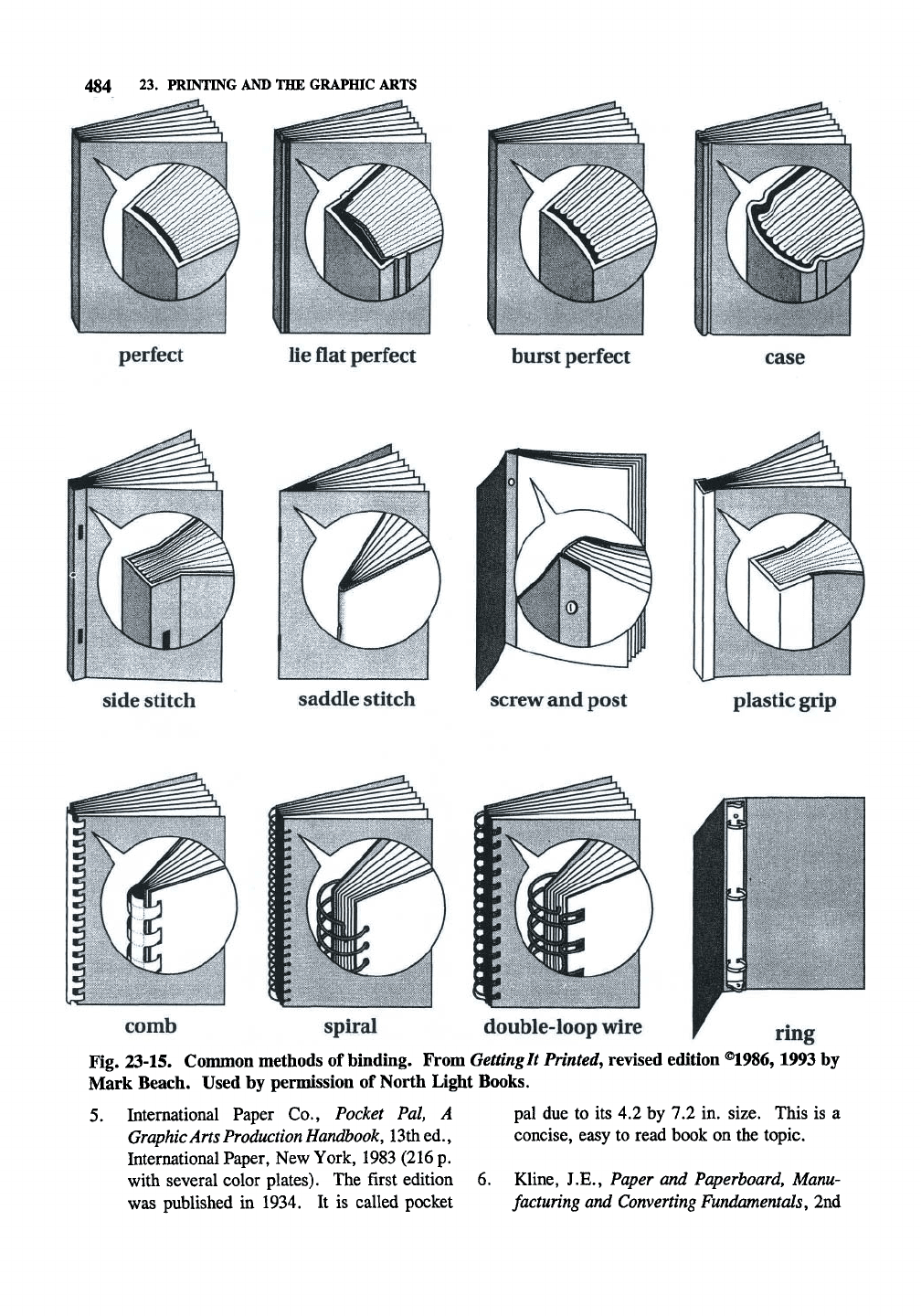
484 23. PRINTING AND THE GRAPHIC ARTS
perfect
lie
flat
perfect
burst
perfect
case
side stitch
saddle stitch
screw and
post
plastic grip
comb spiral double-loop
wire
y ^i^a
Fig. 23-15. Common methods of binding. From Getting It
Printed,
revised edition ®1986,1993 by
Mark Beach. Used by permission of North Light Books.
International Paper Co., Pocket Pal, A
Graphic Arts
Production
Handbook,
13th ed.,
International Paper, New York, 1983 (216 p.
with several color plates). The first edition
was published in 1934. It is called pocket
pal due to its 4.2 by 7.2 in. size. This is a
concise, easy to read book on the topic.
Kline, J.E., Paper and
Paperboard,
Manu-
facturing and
Converting
Fundamentals, 2nd
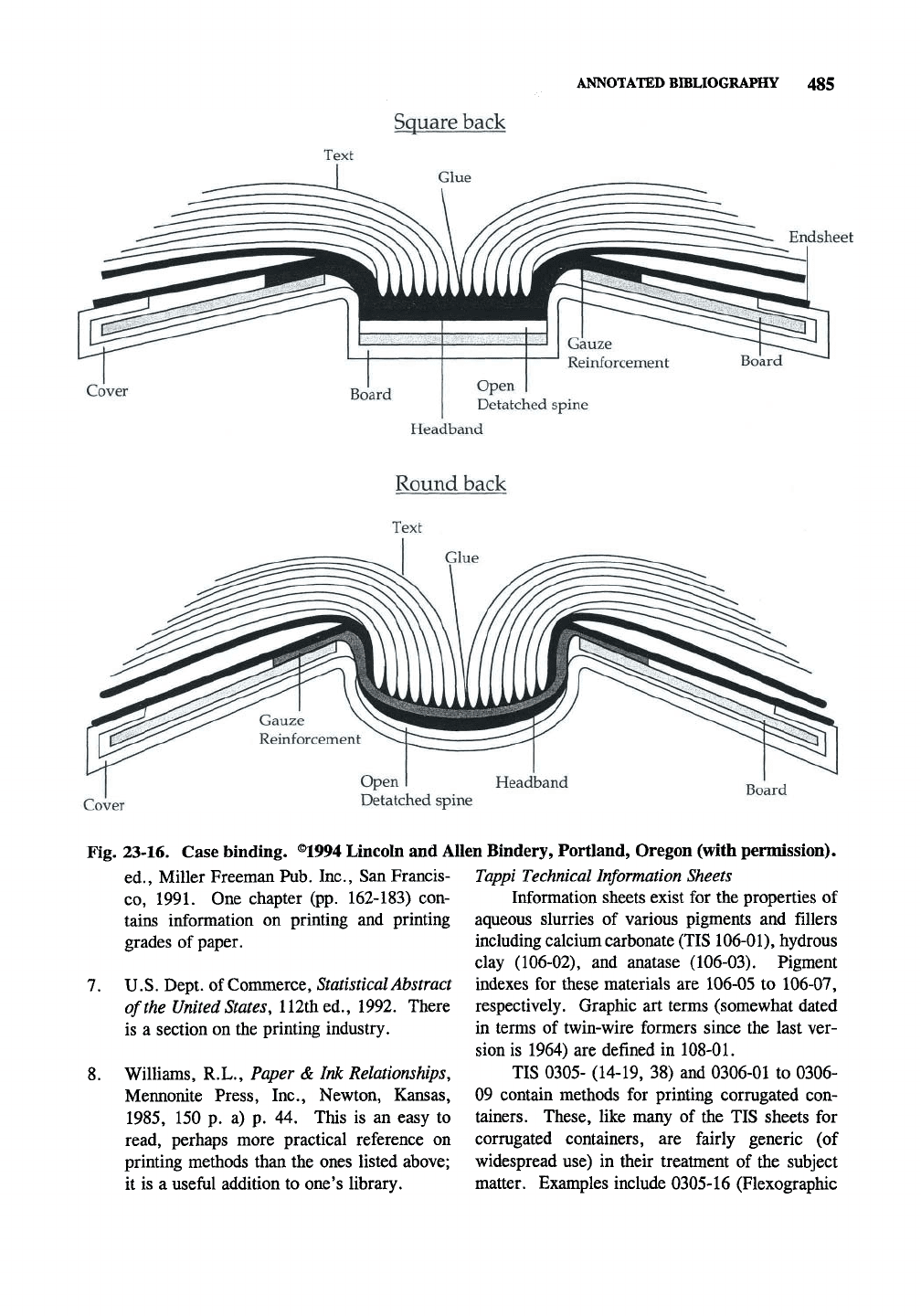
ANNOTATED BffiLIOGRAPHY 485
Square back
Text
Endsheet
Cover
Board
Board
Open
Detatched spine
Headband
Round back
Text
Cover
Open I Headband
Detatched spine
Board
Fig. 23-16. Case binding. ®1994 Lincoln and Allen Bindery, Portland, Oregon (with permission).
ed., Miller Freeman Pub. Inc., San Francis-
co,
1991. One chapter (pp. 162-183) con-
tains information on printing and printing
grades of paper.
U.S.
Dept. of Commerce, Statistical Abstract
of the
United
States, 112th ed., 1992. There
is a section on the printing industry.
Williams, R.L., Paper & Ink Relationships,
Mennonite Press, Inc., Newton, Kansas,
1985,
150 p. a) p. 44. This is an easy to
read, perhaps more practical reference on
printing methods than the ones listed above;
it is a useful addition to one's library.
Tappi Technical Information Sheets
Information sheets exist for the properties of
aqueous slurries of various pigments and fillers
including calcium carbonate (TIS 106-01), hydrous
clay (106-02), and anatase (106-03). Pigment
indexes for these materials are 106-05 to 106-07,
respectively. Graphic art terms (somewhat dated
in terms of twin-wire formers since the last ver-
sion is 1964) are defined in
108-01.
TIS 0305- (14-19, 38) and 0306-01 to 0306-
09 contain methods for printing corrugated con-
tainers. These, like many of the TIS sheets for
corrugated containers, are fairly generic (of
widespread use) in their treatment of the subject
matter. Examples include 0305-16 (Flexographic
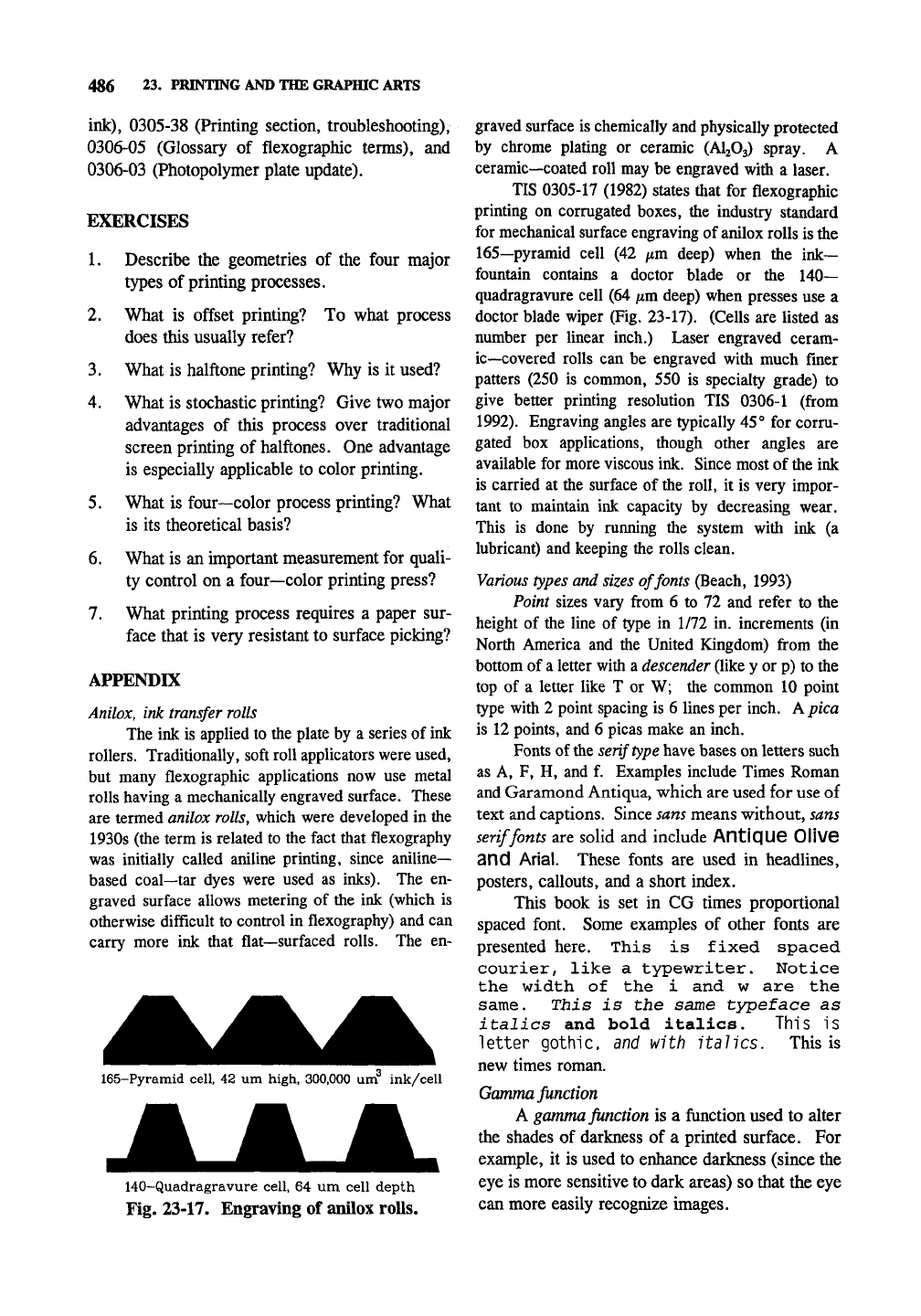
486 23. PRINTING
AND THE
GRAPHIC ARTS
ink),
0305-38 (Printing section, troubleshooting),
0306-05 (Glossary of flexographic terms), and
0306-03 (Photopolymer plate update).
EXERCISES
1.
Describe the geometries of the four major
types of printing processes.
2.
What is offset printing? To what process
does this usually refer?
3.
What is halftone printing? Why is it used?
4.
What is stochastic printing? Give two major
advantages of this process over traditional
screen printing of halftones. One advantage
is especially applicable to color printing.
5.
What is four—color process printing? What
is its theoretical basis?
6. What is an important measurement for quali-
ty control on a four—color printing press?
7.
What printing process requires a paper sur-
face that is very resistant to surface picking?
APFElSfDIX
Anilox, ink
transfer rolls
The ink is applied to the plate by a series of ink
rollers. Traditionally, soft roll applicators were used,
but many flexographic applications now use metal
rolls having a mechanically engraved surface. These
are termed
anilox
rolls,
which were developed in the
1930s (the term is related to the fact that flexography
was initially called aniline printing, since aniline-
based coal—tar dyes were used as inks). The en-
graved surface allows metering of the ink (which is
otherwise difficult to control in
flexography)
and can
carry more ink that flat—surfaced rolls. The en-
165-Pyramid cell. 42 um high. 300.000 um ink/cell
i40-Quadragravure cell, 64 um cell depth
Fig. 23-17. Engraving of anilox rolls.
graved surface is chemically and physically protected
by chrome plating or ceramic (AI2O3) spray. A
ceramic—coated roll may be engraved with a laser.
TIS 0305-17 (1982) states that for flexographic
printing on corrugated boxes, the industry standard
for mechanical surface engraving of anilox rolls is the
165—pyramid cell (42 fim deep) when the ink-
fountain contains a doctor blade or the 140—
quadragravure cell (64 /xm deep) when presses use a
doctor blade wiper (Fig. 23-17). (Cells are listed as
number per linear inch.) Laser engraved ceram-
ic—covered rolls can be engraved with much finer
patters (250 is common, 550 is specialty grade) to
give better printing resolution TIS 0306-1 (from
1992).
Engraving angles are typically 45° for corru-
gated box applications, though other angles are
available for more viscous ink. Since most of
the
ink
is carried at the surface of the roll, it is very impor-
tant to maintain ink capacity by decreasing wear.
This is done by running the system with ink (a
lubricant) and keeping the rolls clean.
Various types and sizes
of fonts (Beach, 1993)
Point sizes vary
ft-om
6 to 72 and refer to the
height of the line of type in 1/72 in. increments (in
North America and the United Kingdom) from the
bottom of
a
letter witii a
descender
(like y or p) to the
top of a letter like T or W; the common 10 point
type with 2 point spacing is 6 lines per inch.
A
pica
is 12 points, and 6 picas make an inch.
Fonts of
the
serif
type
have bases on letters such
as A, F, H, and f. Examples include Times Roman
and Garamond Antiqua, which are used for use of
text and captions. Since
sans
means without, sans
serif fonts are solid and include Antique Ollve
and Arial. These fonts are used in headlines,
posters, callouts, and a short index.
This book is set in CG times proportional
spaced font. Some examples of other fonts are
presented here. This is fixed spaced
courier, like a typewriter. Notice
the width of the i and w are the
same. This is the same typeface as
italics and bold italics. This is
letter gothic. and with Italics. This is
new times roman.
Gamma function
A gamma function is a function used to alter
the shades of darkness of a printed surface. For
example, it is used to enhance darkness (since the
eye is more sensitive to dark areas) so that the eye
can more easily recognize images.
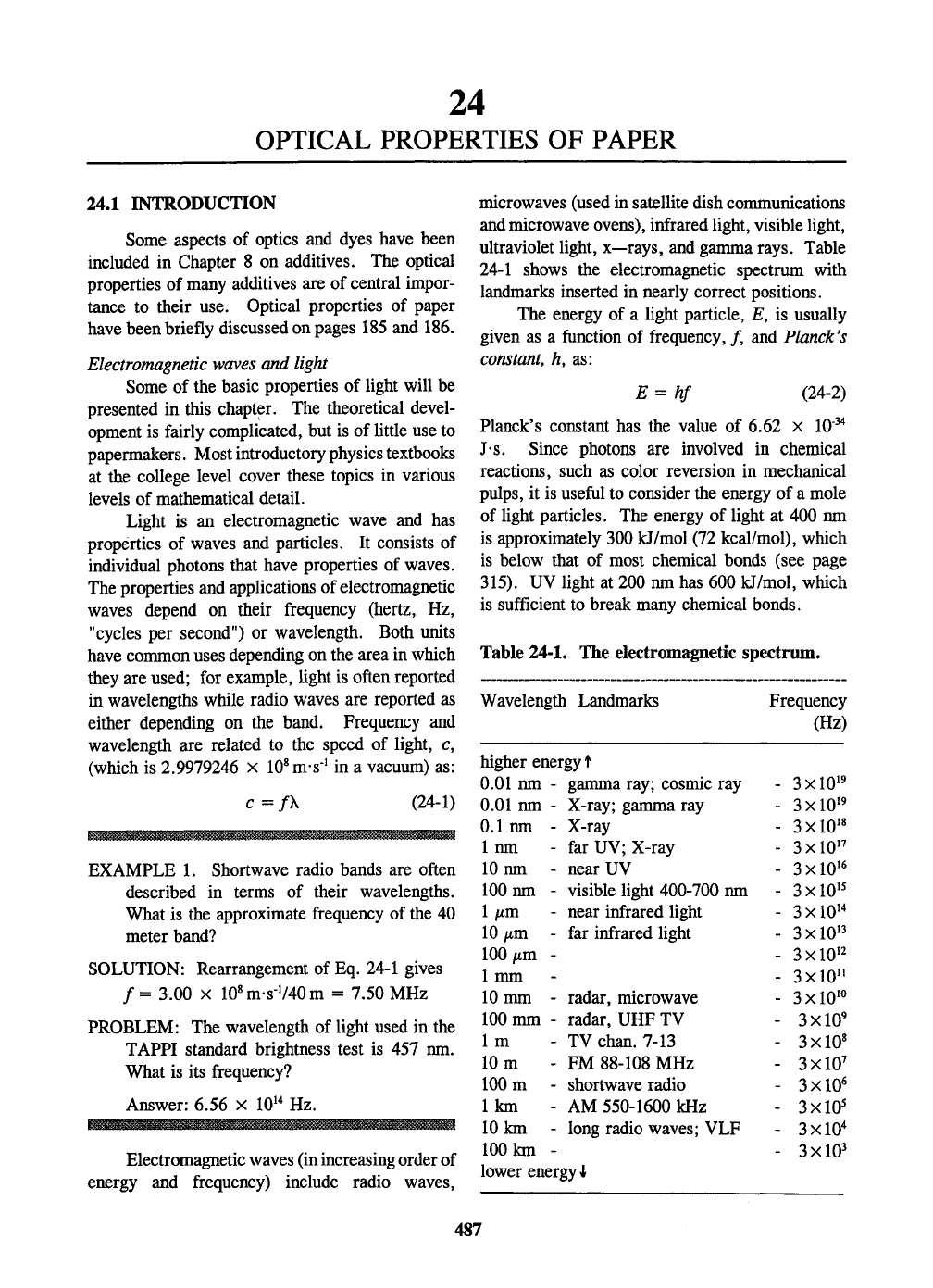
24
OPTICAL PROPERTIES OF PAPER
24.1 INTRODUCTION
Some aspects of optics and dyes have been
included in Chapter 8 on additives. The optical
properties of many additives are of central impor-
tance to their use. Optical properties of paper
have been briefly discussed on pages 185 and 186.
Electromagnetic waves and light
Some of the basic properties of hght will be
presented in this chapter. The theoretical devel-
opment is fairly complicated, but is of little use to
papermakers. Most introductory physics textbooks
at the college level cover these topics in various
levels of mathematical detail.
Light is an electromagnetic wave and has
properties of waves and particles. It consists of
individual photons that have properties of waves.
The properties and applications of electromagnetic
waves depend on their frequency (hertz, Hz,
"cycles per second") or wavelength. Both units
have common uses depending on the area in which
they are used; for example, light is often reported
in wavelengths while radio waves are reported as
either depending on the band. Frequency and
wavelength are related to the speed of light, c,
(which is 2.9979246 x 10*m-s-^ in a vacuum) as:
c=/X
(24-1)
EXAMPLE 1. Shortwave radio bands are often
described in terms of their wavelengths.
What is the approximate frequency of the 40
meter band?
SOLUTION: Rearrangement of Eq. 24-1 gives
/= 3.00 X 10«m-s-V40m = 7.50 MHz
PROBLEM: The wavelength of light used in the
TAPPI standard brightness test is 457 nm.
What is its frequency?
Answer: 6.56 X 10^^ Hz.
Electromagnetic waves
(in
increasing order of
energy and frequency) include radio waves.
microwaves (used in satellite dish conmiunications
and microwave ovens), infrared light, visible light,
ultraviolet light, x—rays, and gamma rays. Table
24-1 shows the electromagnetic spectrum with
landmarks inserted in nearly correct positions.
The energy of a light particle, E, is usually
given as a ftmction of frequency, /, and Planck's
constant, h, as:
E
= hf (24-2)
Planck's constant has the value of 6.62 x 10'^
J-s.
Since photons are involved in chemical
reactions, such as color reversion in mechanical
pulps,
it is useftil to consider the energy of a mole
of light particles. The energy of light at 400 nm
is approximately 300 kJ/mol (72 kcal/mol), which
is below that of most chemical bonds (see page
315).
UV light at 200 nm has 600 kJ/mol, which
is sufficient to break many chemical bonds.
Table 24-1. The electromagnetic spectrum.
Wavelength Landmarks
higher energy!
0.01 nm
0.01 nm
0.1 nm
1 nm
10 nm
100 nm
1 iim
10 /xm
100
fim
1 mm
10 mm
100 mm
1 m
10 m
100 m
1 km
10 km
100 km
- gamma ray; cosmic ray
- X-ray; gamma ray
- X-ray
- far UV; X-ray
- near UV
- visible light 400-700 nm
- near infrared light
- far infrared light
-
-
- radar, microwave
- radar, UHF TV
- TV Chan. 7-13
- FM 88-108 MHz
- shortwave radio
- AM 550-1600 kHz
- long radio waves; VLF
-
lower energy 1
Frequency
(Hz)
- 3x10^9
- 3x10^^
- 3xlO^«
- 3x10^^
- 3x10^^
- 3x10^5
- 3x10^^
- 3x10^3
- 3x10^2
- 3x10^1
- 3x10^0
- 3x10^
- 3x10^
- 3x10'
- 3x10^
- 3x10^
- 3x10^
- 3x10^
487
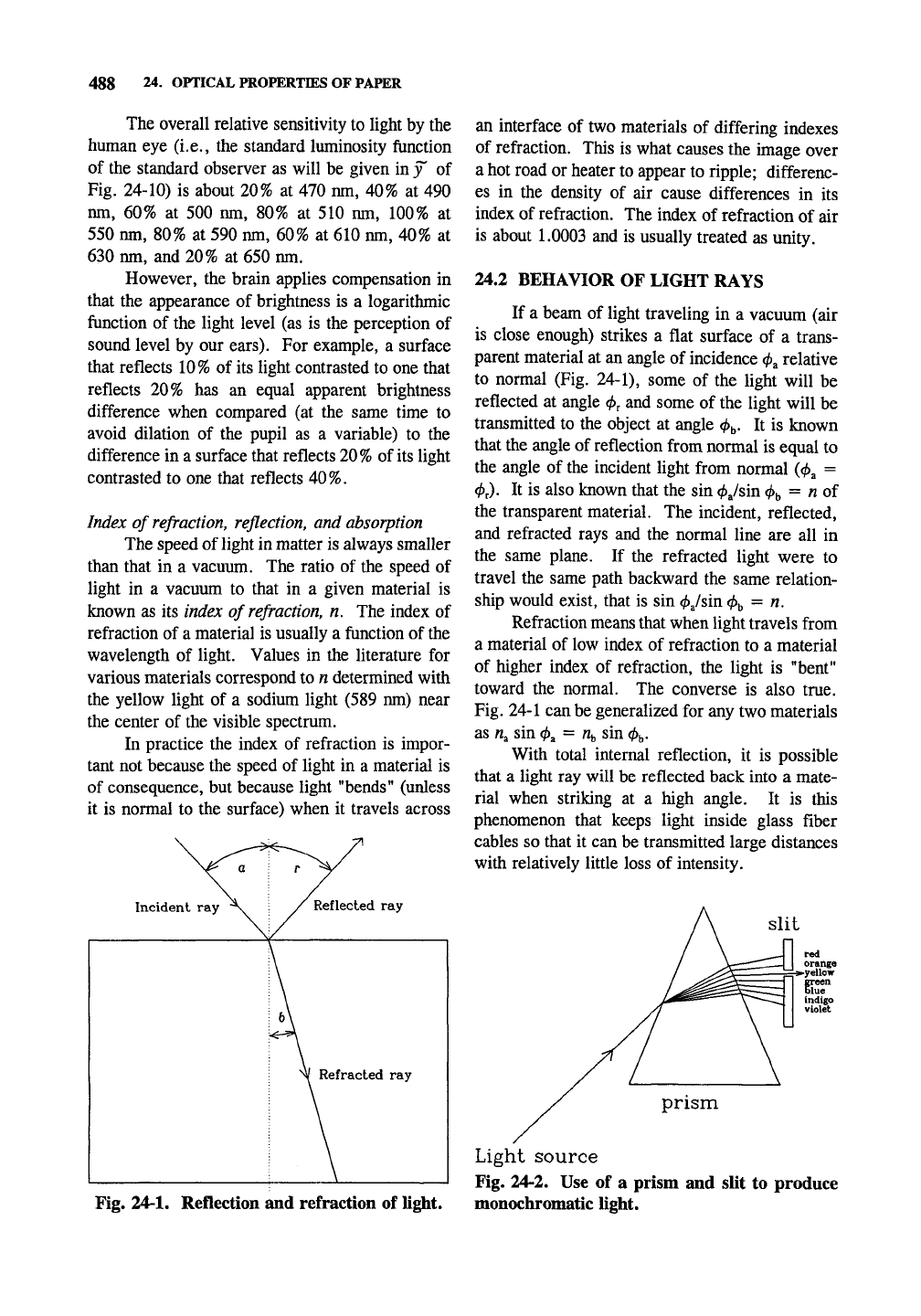
488 24. OPTICAL PROPERTffiS OF PAPER
The overall relative sensitivity to light by the
human eye (i.e., the standard luminosity function
of the standard observer as will be given in jT of
Fig. 24-10) is about 20% at 470 nm, 40% at 490
nm, 60% at 500 nm, 80% at 510 nm, 100% at
550 nm, 80% at 590 nm, 60% at 610 nm, 40% at
630 nm, and 20% at 650 nm.
However, the brain applies compensation in
that the appearance of brightness is a logarithmic
function of the light level (as is the perception of
sound level by our ears). For example, a surface
that reflects 10% of its light contrasted to one that
reflects 20% has an equal apparent brightness
difference when compared (at the same time to
avoid dilation of the pupil as a variable) to the
difference in a surface that reflects 20% of
its
light
contrasted to one that reflects 40%.
Index of
refraction,
reflection, and absorption
The speed of light in matter is always smaller
than that in a vacuum. The ratio of the speed of
light in a vacuum to that in a given material is
known as its index of
refraction,
n. The index of
refraction of a material is usually a function of the
wavelength of light. Values in the literature for
various materials correspond to n determined with
the yellow light of a sodium light (589 nm) near
the center of the visible spectrum.
In practice the index of refraction is impor-
tant not because the speed of light in a material is
of consequence, but because light "bends" (unless
it is normal to the surface) when it travels across
\^ a
Incident ray \
/ Reflected ray
N/
Refracted ray
an interface of two materials of differing indexes
of refraction. This is what causes the image over
a hot road or heater to appear to ripple; differenc-
es in the density of air cause differences in its
index of refraction. The index of refraction of air
is about
1.0003
and is usually treated as unity.
24.2 BEHAVIOR OF LIGHT RAYS
If a beam of light traveling in a vacuum (air
is close enough) strikes a flat surface of a trans-
parent material at an angle of incidence
(f)^
relative
to normal (Fig. 24-1), some of the light will be
reflected at angle
4>,
and some of the light will be
transmitted to the object at angle 0b. It is known
that the angle of reflection from normal is equal to
the angle of the incident light from normal (0^ =
0r).
It is also known that the sin ^J^m
01,
=
AZ
of
the transparent material. The incident, reflected,
and refracted rays and the normal line are all in
the same plane. If the refracted light were to
travel the same path backward the same relation-
ship would exist, that is sin ^^sin
(t>^
= n.
Refraction means that when light travels from
a material of low index of refraction to a material
of higher index of refraction, the light is "bent"
toward the normal. The converse is also true.
Fig. 24-1 can be generalized for any two materials
as «a sin 0^ = ^b sin 0^.
With total internal reflection, it is possible
that a light ray will be reflected back into a mate-
rial when striking at a high angle. It is this
phenomenon that keeps light inside glass fiber
cables so that it can be transmitted large distances
with relatively little loss of intensity.
Fig. 24-1. Reflection and refraction of light.
prism
Light source
Fig. 24-2. Use of a prism and slit to produce
monochromatic light.
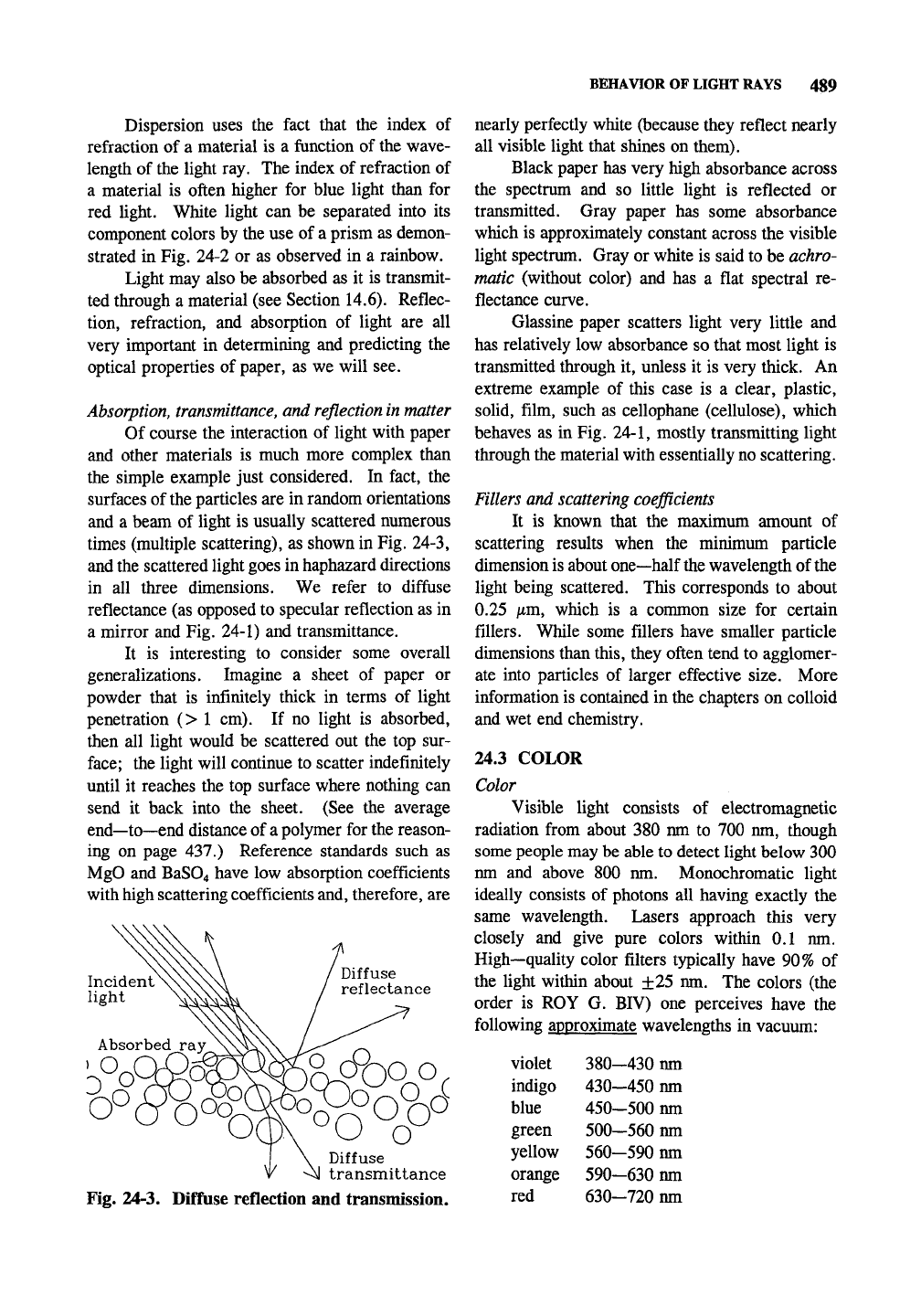
BEHAVIOR OF LIGHT RAYS 489
Dispersion uses the fact that the index of
refraction of a material is a function of the wave-
length of the light ray. The index of refraction of
a material is often higher for blue light than for
red light. White light can be separated into its
component colors by the use of a prism as demon-
strated in Fig. 24-2 or as observed in a rainbow.
Light may also be absorbed as it is transmit-
ted through a material (see Section 14.6). Reflec-
tion, refraction, and absorption of light are all
very important in determining and predicting the
optical properties of paper, as we will see.
Absorption, transmittance, and
reflection
in matter
Of course the interaction of light with paper
and other materials is much more complex than
the simple example just considered. In fact, the
surfaces of
the
particles are in random orientations
and a beam of light is usually scattered numerous
times (multiple scattering), as shown in Fig. 24-3,
and the scattered light goes in haphazard directions
in all three dimensions. We refer to diffuse
reflectance (as opposed to specular reflection as in
a mirror and Fig. 24-1) and transmittance.
It is interesting to consider some overall
generalizations. Imagine a sheet of paper or
powder that is infinitely thick in terms of light
penetration (> 1 cm). If no light is absorbed,
then all light would be scattered out the top sur-
face;
the light will continue to scatter indefinitely
until it reaches the top surface where nothing can
send it back into the sheet. (See the average
end—to—end distance of a polymer for the reason-
ing on page 437.) Reference standards such as
MgO and BaS04 have low absorption coefficients
with high scattering coefficients and, therefore, are
Diffuse
reflectance
o
Diffuse
transmittance
Fig. 24-3. Diffuse reflection and transmission.
nearly perfectly white (because they reflect nearly
all visible light that shines on them).
Black paper has very high absorbance across
the spectrum and so little light is reflected or
transmitted. Gray paper has some absorbance
which is approximately constant across the visible
light spectrum. Gray or white is said to be achro-
matic (without color) and has a flat spectral re-
flectance curve.
Glassine paper scatters light very little and
has relatively low absorbance so that most light is
transmitted through it, unless it is very thick. An
extreme example of this case is a clear, plastic,
solid, film, such as cellophane (cellulose), which
behaves as in Fig. 24-1, mostly transmitting light
through the material with essentially no scattering.
Fillers and scattering coefficients
It is known that the maximum amount of
scattering results when the minimum particle
dimension is about one—half
the
wavelength of the
light being scattered. This corresponds to about
0.25 jLtm, which is a common size for certain
fillers.
While some fillers have smaller particle
dimensions than this, they often tend to agglomer-
ate into particles of larger effective size. More
information is contained in the chapters on colloid
and wet end chemistry.
24.3 COLOR
Color
Visible light consists of electromagnetic
radiation from about 380 nm to 700 nm, though
some people may be able to detect light below 300
nm and above 800 nm. Monochromatic light
ideally consists of photons all having exactly the
same wavelength. Lasers approach this very
closely and give pure colors within 0.1 nm.
High—quality color filters typically have 90% of
the light within about ±25 nm. The colors (the
order is ROY G. BIV) one perceives have the
following approximate wavelengths in vacuum:
violet
indigo
blue
green
yellow
orange
red
380—430 nm
430-450 nm
450—500 nm
500-560 nm
560-590 nm
590-630 nm
630-720 nm
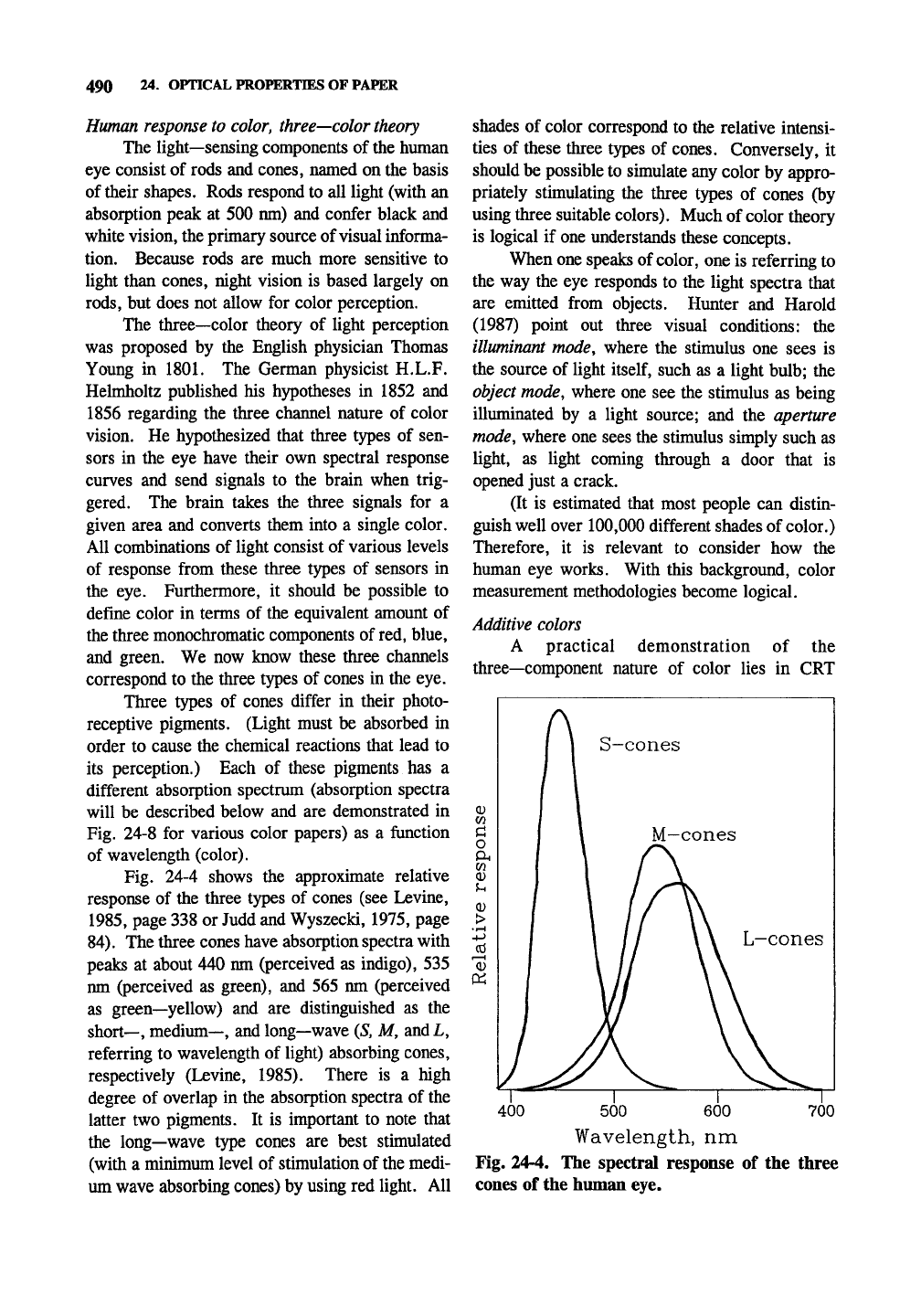
490 24. OPTICAL PROPERTIES OF PAPER
Human response to color, three—color
theory
The light—sensing components of the human
eye consist of rods and cones, named on the basis
of their shapes. Rods respond to all light (with an
absorption peak at 500 nm) and confer black and
white vision, the primary source of visual informa-
tion. Because rods are much more sensitive to
light than cones, night vision is based largely on
rods,
but does not allow for color perception.
The three—color theory of light perception
was proposed by the English physician Thomas
Young in 1801. The German physicist H.L.F.
Helmholtz published his hypotheses in 1852 and
1856 regarding the three channel nature of color
vision. He hypothesized that three types of sen-
sors in the eye have their own spectral response
curves and send signals to the brain when trig-
gered. The brain takes the three signals for a
given area and converts them into a single color.
All combinations of light consist of various levels
of response from these three types of sensors in
the eye. Furthermore, it should be possible to
define color in terms of the equivalent amount of
the three monochromatic components of red, blue,
and green. We now know these three channels
correspond to the three types of cones in the eye.
Three types of cones differ in their photo-
receptive pigments. (Light must be absorbed in
order to cause the chemical reactions that lead to
its perception.) Each of these pigments has a
different absorption spectrum (absorption spectra
will be described below and are demonstrated in
Fig. 24-8 for various color papers) as a function
of wavelength (color).
Fig. 24-4 shows the approximate relative
response of the three types of cones (see Levine,
1985,
page 338 or Judd and Wyszecki, 1975, page
84).
The three cones have absorption spectra with
peaks at about 440 nm (perceived as indigo), 535
nm (perceived as green), and 565 nm (perceived
as green—yellow) and are distinguished as the
short—, medium—, and long—wave (5, M, andL,
referring to wavelength of light) absorbing cones,
respectively (Levine, 1985). There is a high
degree of overlap in the absorption spectra of the
latter two pigments. It is important to note that
the long—wave type cones are best stimulated
(with a minimum level of stimulation of the medi-
um wave absorbing cones) by using red light. All
shades of color correspond to the relative intensi-
ties of these three types of cones. Conversely, it
should be possible to simulate any color by appro-
priately stimulating the three types of cones (by
using three suitable colors). Much of color theory
is logical if one understands these concepts.
When one speaks of
color,
one is referring to
the way the eye responds to the light spectra that
are emitted from objects. Hunter and Harold
(1987) point out three visual conditions: the
illuminant mode, where the stimulus one sees is
the source of light
itself,
such as a light bulb; the
object mode, where one see the stimulus as being
illuminated by a light source; and the aperture
mode, where one sees the stimulus simply such as
light, as light coming through a door that is
opened just a crack.
(It is estimated that most people can distin-
guish well over 100,000 different shades of color.)
Therefore, it is relevant to consider how the
human eye works. With this background, color
measurement methodologies become logical.
Additive colors
A practical demonstration of the
three—component nature of color lies in CRT
S-cones
M-cones
L-cones
400 700
500 600
Wavelength, nm
Fig. 24-4. The spectral response of the three
cones of the human eye.
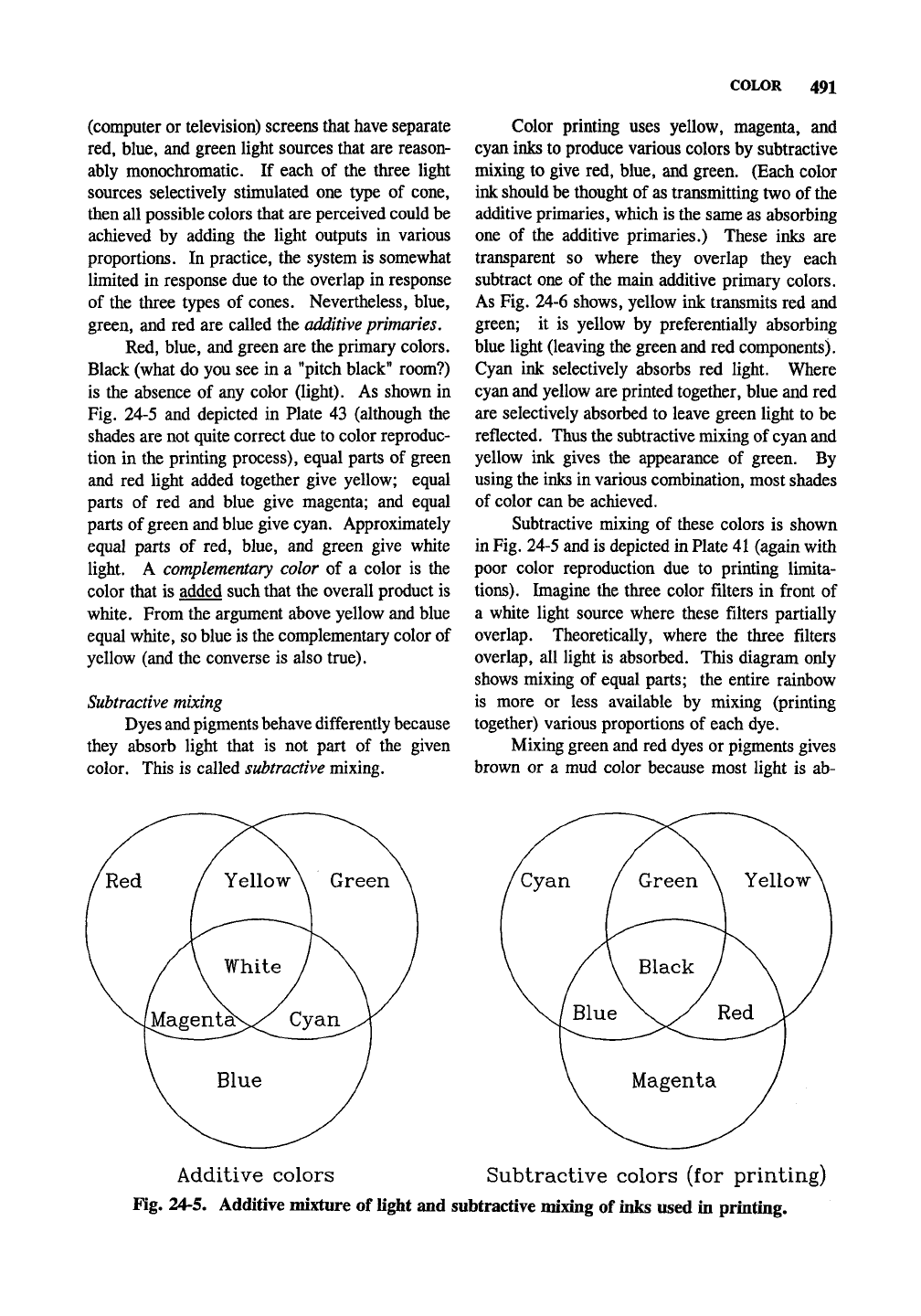
COLOR 491
(computer or television) screens that have separate
red,
blue, and green light sources that are reason-
ably monochromatic. If each of the three light
sources selectively stimulated one type of cone,
then all possible colors that are perceived could be
achieved by adding the light outputs in various
proportions. In practice, the system is somewhat
limited in response due to the overlap in response
of the three types of cones. Nevertheless, blue,
green, and red are called the
additive
primaries.
Red, blue, and green are the primary colors.
Black (what do you see in a "pitch black" room?)
is the absence of any color (light). As shown in
Fig. 24-5 and depicted in Plate 43 (although the
shades are not quite correct due to color reproduc-
tion in the printing process), equal parts of green
and red light added together give yellow; equal
parts of red and blue give magenta; and equal
parts of green and blue give cyan. Approximately
equal parts of red, blue, and green give white
light. A complementary color of a color is the
color that is added such that the overall product is
white. From the argument above yellow and blue
equal white, so blue is the complementary color of
yellow (and the converse is also true).
Suhtractive mixing
Dyes
and pigments behave
differently because
they absorb light that is not part of the given
color. This is called
suhtractive
mixing.
Color printing uses yellow, magenta, and
cyan inks to produce various colors by suhtractive
mixing to give red, blue, and green. (Each color
ink should be thought of
as
transmitting two of the
additive primaries, which is the same as absorbing
one of the additive primaries.) These inks are
transparent so where they overlap they each
subtract one of the main additive primary colors.
As Fig. 24-6 shows, yellow ink transmits red and
green; it is yellow by preferentially absorbing
blue light (leaving the green
and
red components).
Cyan ink selectively absorbs red light. Where
cyan
and
yellow are printed together, blue and red
are selectively absorbed to leave green light to be
reflected. Thus the suhtractive mixing of
cyan
and
yellow ink gives the appearance of green. By
using the inks in various combination, most shades
of color can be achieved.
Suhtractive mixing of these colors is shown
in
Fig.
24-5 and is depicted in Plate 41 (again with
poor color reproduction due to printing limita-
tions).
Imagine the three color filters in front of
a white light source where these filters partially
overlap. Theoretically, where the three filters
overlap, all light is absorbed. This diagram only
shows mixing of equal parts; the entire rainbow
is more or less available by mixing (printing
together) various proportions of each dye.
Mixing green and red dyes or pigments gives
brown or a mud color because most light is ab-
Additive colors Suhtractive colors (for printing)
Fig. 24-5. Additive mixture of light and suhtractive mixing of inks used in printing.
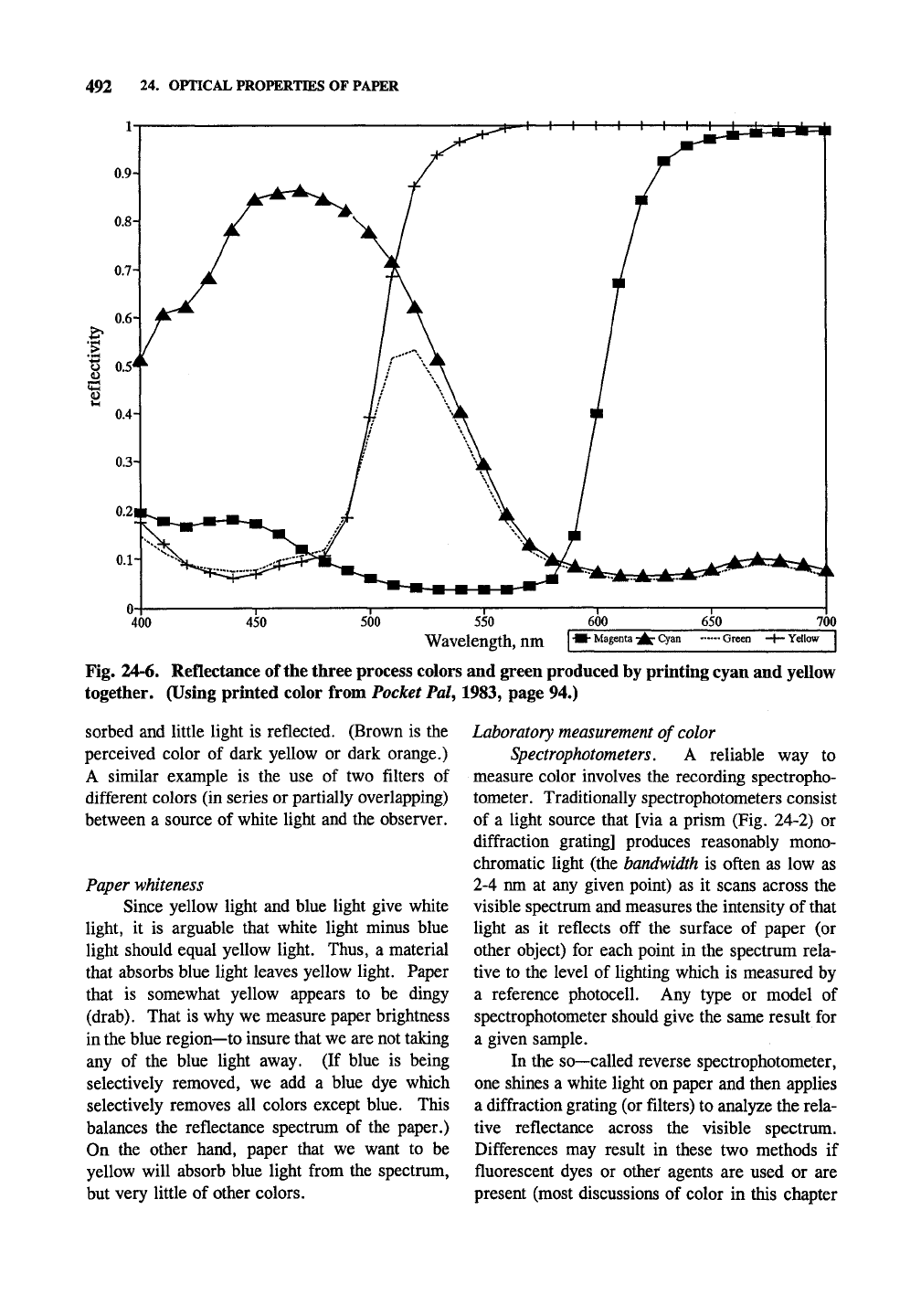
492 24. OPTICAL PROPERTffiS OF PAPER
1
Wavelength, nm
Fig. 24-6. Reflectance of the three process colors and green produced by prmting cyan and yellow
together. (Using printed color from Pocket Pal, 1983, page 94.)
sorbed and little light is reflected. (Brown is the
perceived color of dark yellow or dark orange.)
A similar example is the use of two filters of
different colors (in series or partially overlapping)
between a source of white light and the observer.
Paper whiteness
Since yellow light and blue light give white
light, it is arguable that white light minus blue
light should equal yellow light. Thus, a material
that absorbs blue light leaves yellow light. Paper
that is somewhat yellow appears to be dingy
(drab).
That is why we measure paper brightness
in the blue region—to insure that we are not taking
any of the blue light away. (If blue is being
selectively removed, we add a blue dye which
selectively removes all colors except blue. This
balances the reflectance spectrum of the paper.)
On the other hand, paper that we want to be
yellow will absorb blue light from the spectrum,
but very little of other colors.
Laboratory measurement of
color
Spectrophotometers, A reliable way to
measure color involves the recording spectropho-
tometer. Traditionally spectrophotometers consist
of a light source that [via a prism (Fig. 24-2) or
diffraction grating] produces reasonably mono-
chromatic light (the bandwidth is often as low as
2-4 nm at any given point) as it scans across the
visible spectrum and measures the intensity of that
light as it reflects off the surface of paper (or
other object) for each point in the spectrum rela-
tive to the level of lighting which is measured by
a reference photocell. Any type or model of
spectrophotometer should give the same result for
a given sample.
In the so—called reverse spectrophotometer,
one shines a white light on paper and then applies
a diffraction grating (or filters) to analyze the rela-
tive reflectance across the visible spectrum.
Differences may result in these two methods if
fluorescent dyes or other agents are used or are
present (most discussions of color in this chapter
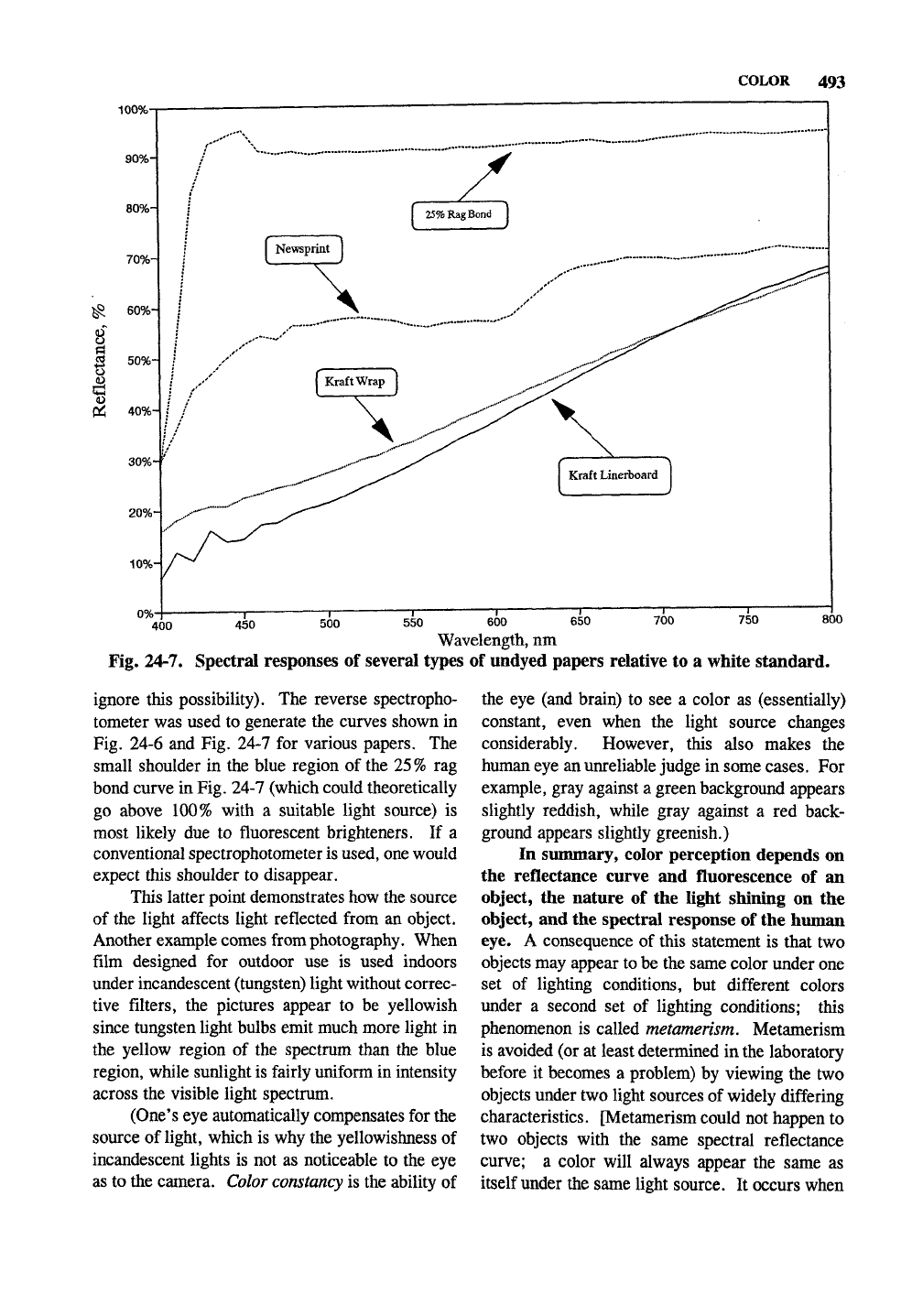
COLOR 493
100%-
90%H
80%H
70%H
0%-
Kraft Linerboard
400
450
—I—
500
550
600
650
700 750
800
Wavelength, nm
Fig. 24-7. Spectral responses of several types of undyed papers relative to a white standard.
ignore this possibility). The reverse spectropho-
tometer was used to generate the curves shown in
Fig. 24-6 and Fig. 24-7 for various papers. The
small shoulder in the blue region of the 25% rag
bond curve in Fig. 24-7 (which could theoretically
go above 100% with a suitable light source) is
most likely due to fluorescent brighteners. If a
conventional spectrophotometer is used, one would
expect this shoulder to disappear.
This latter point demonstrates how the source
of the light affects light reflected from an object.
Another example comes from photography. When
film designed for outdoor use is used indoors
under incandescent (tungsten) light without correc-
tive filters, the pictures appear to be yellowish
since tungsten light bulbs emit much more light in
the yellow region of the spectrum than the blue
region, while sunlight is fairly uniform in intensity
across the visible light spectrum.
(One's eye automatically compensates for the
source of light, which is why the yellowishness of
incandescent lights is not as noticeable to the eye
as to the camera. Color
constancy
is the ability of
the eye (and brain) to see a color as (essentially)
constant, even when the light source changes
considerably. However, this also makes the
human eye an unreliable judge in some cases. For
example, gray against a green background appears
slightly reddish, while gray against a red back-
ground appears slightly greenish.)
In summary, color perception depends on
the reflectance curve and fluorescence of an
object, the nature of the Ught shining on the
object, and the spectral response of the human
eye.
A consequence of this statement is that two
objects may appear to be the same color under one
set of lighting conditions, but diflerent colors
under a second set of lighting conditions; this
phenomenon is called metamerism. Metamerism
is avoided (or at least determined in the laboratory
before it becomes a problem) by viewing the two
objects under two light sources of widely differing
characteristics. [Metamerism could not happen to
two objects with the same spectral reflectance
curve; a color will always appear the same as
itself under the same light source. It occurs when
